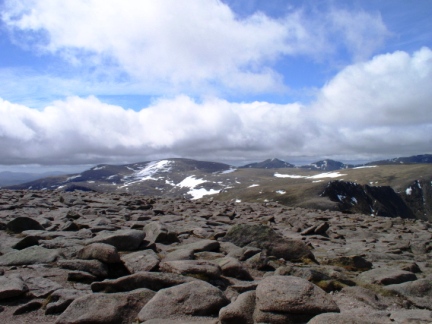The Cairngorms
The Cairngorms - Introduction
Formed in 2003 the Cairngorms National Park was the second National Park to be created in Scotland, in 2010 the park was extended with the addition of a substantial area in the region of Blair Atholl. Today the National Park stretches from Ballater in the east to Dalwhinnie in the west and from Grantown-on-Spey in the north to Blair Atholl in the south. The National Park is the largest in the British Isles and covers approximately 1,467 sq. miles, the equivalent of about 11% of Scotland.
Cairngorms Gallery: Click on the photos below to enlarge.
The National Park contains a wide diversity of features including lowland lochs, moors, substantial tracts of forest, numerous rivers and, of course, mountains, including the Cairngorm mountain range itself. The Cairngorm range contains 5 of the 6 highest mountains, not only in Scotland, but the entire British Isles.
Walks in the Cairngorms
 |
 |
 |
| 23/04/06 - Mount Keen | 26/05/05 - Cairn Gorm | 22/05/05 - Ben Macdui |
What is often termed the Cairngorm plateau is the highest landmass in Britain. Over 36% of the National Park stands over 800m above sea level whilst 2% is over 1,000m. The land over 600m is known as the 'montane zone' and is the largest area of arctic mountain landscape in the British Isles. Snow can stay on the highest mountains for up to 8 months of the year and it is said up in the mountains it is common to experience four seasons in one day, something I discovered when I climbed Ben Macdui.
This weather forecast is generated by the Met Office Weather Widget
Ben Macdui is the highest mountain in the Cairngorms, and the second highest summit in Scotland. As with many of the Cairngorm mountains Ben Macdui can only be reached by an extended trek. Many can only realistically be walked in a day with the additional use of a bicycle to get to a suitable starting point. One of the few major summits in the range that is easily accessible is Cairn Gorm itself, mainly due to its popularity as a ski resort. Mention should also be made of the Cairngorm Mountain Railway. Opened in 2001, it is the highest railway in the country. The highest point on the line is Ptarmigan station standing 1,097m above sea level and about 150m in height below the summit of Cairn Gorm itself.
Away from the mountains large areas of the National Park are covered in substantial tracts of forest including the most extensive areas of native Caledonian forest to be found in Britain. One of the best known areas of Caledonian forest is Rothiemurchus Forest near Aviemore. Covering an area of 30 square kilometres and containing approx 10 million trees Rothiemurchus is famous for its pine trees and is a popular venue for numerous outdoor activities.
The area also contains numerous lowland lochs that provide a more relaxed walking environment than the mountains. From personal experience I can recommend the short walk around Loch an Eilein (Loch of the Island), voted in 2010 as Britain's Best Picnic Spot, whilst bird lovers should also seek out the RSPB reserve at Loch Garten where it is possible to observe nesting ospreys.
Indeed one of the main attractions of the Cairngorms is the wildlife. The forests, rivers and mountains of the Cairngorms are home to a great variety of animal, bird and fish species. Golden Eagle, Dotterell, Capercaillie and Osprey are just some of the birds that can be seen, as is the Scottish Crossbill, the only bird unique to Britain. The rivers contain otters, salmon, trout, lampreys and the endangered freshwater pearl mussel. Pine martens, red squirrels and wildcats can all be found in the forests whilst a visit to the Cairngorm reindeer herd is an experience not to be missed.
I first visited the Cairngorms in 2005 when we stayed in Aviemore. The following year I spent a couple of days in a lonely cottage at the head of Glen Mark below Mount Keen. I absolutely loved both experiences and would like to visit the Cairngorms again one day. However, the sheer vastness of the area is both daunting and somewhat overwhelming. I'm someone who likes to really explore and get to know an area. I imagine one could devote an entire life to walking only in the Cairngorms and still not uncover all its secrets. Instead, like many areas of Scotland, I may have to just settle for targeting selected hills and mountains. In the Cairngorms, if given the opportunity I'd particularly like to climb Braeriach and Lochnagar.











Follow me on ...




